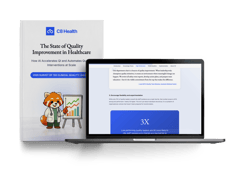
How to Increase Adherence to Best Practices in Healthcare
Healthcare organizations face a persistent challenge: ensuring that their staff adheres to established best practices. For example, one study found that screening adherence to diabetes was only 46%, while another study reports an overall 50% adherence to pre-eclampsia and eclampsia management only.
With better adherence to best practices, healthcare organizations can realize a multitude of benefits, including improved patient outcomes, reduced medical errors, enhanced efficiency, and optimized resource utilization. To foster a culture of best practice adherence, let's explore what constitutes best practices, their significance, and the current obstacles that prevent consistent adherence.
Meet the Expert
Ido Zamberg M.D. is a board-certified physician (General Internal Medicine and Anesthesia), currently a Fellow at the Division of Experimental Medicine at McGill University Health Center in Montreal, Canada.
Setting the Scene: What Are Best Practices and Why Are They Important?
Best practices in healthcare are established guidelines, methods, and approaches that have been proven effective through research and experience.
So, because best practices are vetted and evidence-based, they're essential to delivering high-quality, safe, and efficient healthcare services. They also contribute towards standardizing and coordinating care, because they create a universal foundation that all healthcare professionals can draw from and implement.
Consider how creating evidence-based protocols for acute stroke is effective. In certain situations, multiple health professionals with varying levels of experience and exposure to stroke management may treat stroke patients. However, not all of them have daily experience with acute stroke cases. But protocols based on the latest literature create a standard all health professionals can refer to.
Why Don't Healthcare Professionals Adhere to Best Practices?
Inaccessible and Unidentified Information
Best practices may be inaccessible due to limited resources, outdated infrastructure, or a lack of training. Additionally, best practices may be siloed in different departments, servers, or content formats. This makes it difficult to find the information because there isn't a single hosting platform or access point. In some cases, healthcare professionals may simply not be aware of the guidelines. Our latest white paper provides actionable insights on improving access to information.
Rapidly Updating Medical Information
The rapid evolution of medical knowledge can make it challenging for healthcare professionals to stay current with the latest best practices. Consider that research estimates medical knowledge is current for 73 days only. Keeping up with a constant influx of new information and updates can be overwhelming and time-consuming for healthcare professionals.
Difficulty Tailoring Best Practices for Specific Contexts and Institutions
Best practices are often developed at a general level and adapting them to specific contexts or institutions can be challenging. Healthcare settings vary, and what works well in one context may not be easily transferable to another. Tailoring best practices to suit the unique characteristics of each institution requires careful consideration and effort.
Resistance to Change
Healthcare professionals may resist changes to established routines and practices. Resistance can stem from concerns about disruptions to workflow, skepticism about the benefits of new practices, or a lack of perceived necessity.
Increasing Adherence to Best Practices in Healthcare
1. Emphasize Awareness and Accessibility
To drive adherence, the initial focus is on disseminating best practices and creating a culture that emphasizes their use. Awareness is the first step toward adoption. This can include:
- Providing ongoing education and training programs to ensure healthcare professionals are aware of the latest best practices.
- Making sure healthcare professionals know where to look for updated best practices.
This leads to the second part: accessibility. To reach optimal effectiveness, healthcare professionals must have easy access to best practices. This necessitates a digital knowledge management solution that's available on any electronic device and can be accessed at any point. By centralizing best practices in a single source, healthcare professionals don't have to search endless files and databases anymore.
Additionally, a digital solution means no more duplicates or outdated versions. The platform streamlines access to one copy that can be edited in real-time, ensuring healthcare professionals don't access the wrong information. This saves time and alleviates administrative burdens.
Anesthesiologist, Max Feinstein M.D. shares how C8 Health's platform has enhanced medical guidance management:
» Explore more strategies for effective knowledge management
2. Leaders Must Set the Tone
Leadership within healthcare institutions plays a pivotal role in promoting adherence to best practices. Whether it's a department chair or a service line chair emphasizing specific protocols, their leadership sets the tone. Effective leadership strategies, such as evidence-based protocol creation, establish a common language among healthcare professionals and significantly improve patient outcomes.
Leadership not only emphasizes the importance of adherence but also sets the tone for its adoption. When a specific protocol is emphasized at the department or service line level, it creates a ripple effect. A hospital-wide policy further elevates compliance rates. The understanding that best practices are essential for patient safety and improved outcomes is key to fostering adherence.
When it becomes a policy of the hospital, everyone would use it. Everyone would use it, not because it's mandatory, it's because they understand that this is their tool to make sure that patient safety is ensured and that the patient outcomes are better.
3. Implement Reinforcement and Use Real-Time Insights
The final step to securing adherence is reinforcing its adoption. While real-time tools for monitoring adherence to best practices are limited, they're constantly evolving.
C8 Health's system offers a significant step forward, providing real-time data-driven insights on protocol usage. With advanced analytics on content consumption and engagement, healthcare organizations can pinpoint any gaps in healthcare and close them.
Real-time monitoring allows for a proactive approach, promptly addressing adherence challenges.
Unleashing the Potential for Adherence
Enhancing adherence to best practices is a continuous journey in healthcare. By disseminating best practices, fostering leadership, embracing evidence-based protocols, and utilizing real-time monitoring tools, healthcare organizations can empower their staff to provide the best possible care.
C8 Health bridges the knowledge gap by ensuring healthcare professionals strive to provide the highest quality care, stay informed about emerging trends, and know that innovations are vital. With the right strategies and tools in place, healthcare organizations can pave the way for a brighter, more patient-centered future.


